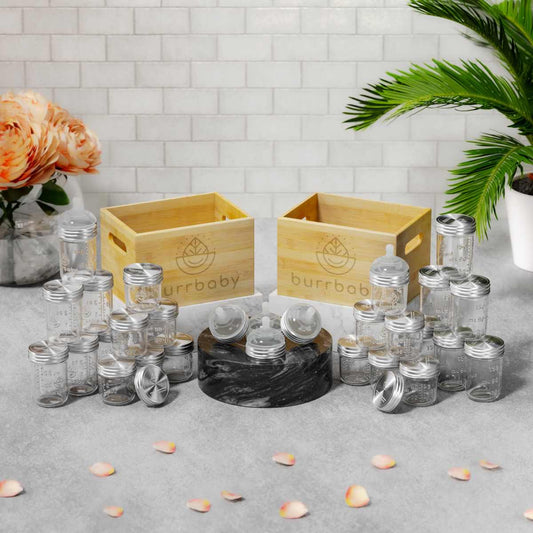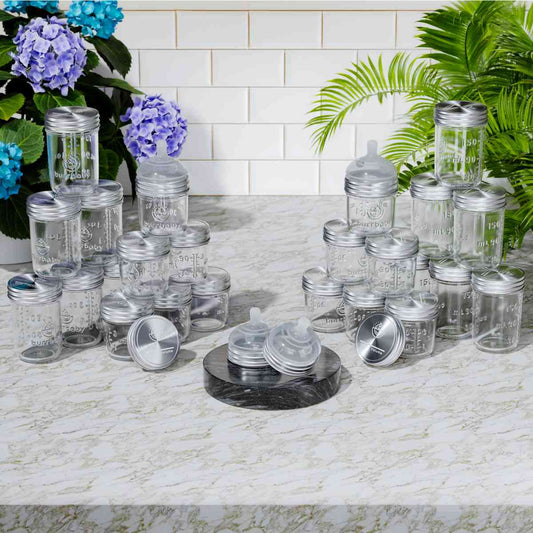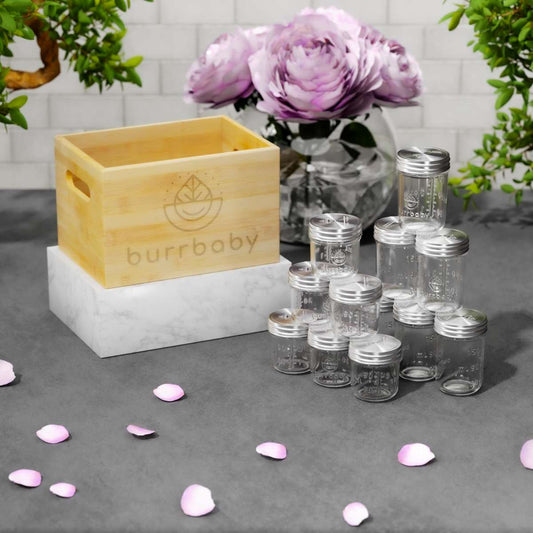Breast milk provides your baby with nutrients to help them grow, antibodies to build their immune system, and hormones to foster healthy growth and development.
The American Academy of Pediatrics recommends exclusive feeding you baby breast milk for at least the first six months of life, followed by continued breast milk feeding alongside the introduction of complementary foods until at least 12 months of age.
In today's world, modern parenting often requires a mix of breastfeeding and pumping with bottle feeding as mom's go back to work, school, or really any other time they might not be directly with their baby.
This means that when you pump, you're going to need a place to store your breast milk! But how often do we think about how the type of container we choose will affect not only the quality of our breast milk, but the health of our babies and the planet?
In today's article, you'll learn a bit more about how important it is to consider how you store breast milk, and why glass might be the best option for you and your baby.
Article Overview
- Introducing glass storage containers: a healthier and more sustainable alternative
- Advantages of glass containers for breast milk storage
- Burrbaby's Glass Breast Milk Storage Containers: A Safe and Non-Toxic Choice
- Best Practices When Using Glass Containers for Breast Milk Storage
At Burrbaby, we're dedicated to being a part of a healthier world for your children. We hope to accomplish this through our zero-plastic glass breast milk storage containers and bottles. These completely non-toxic, sustainable choices protect your baby's health and our planet.
Overview of common breast milk storage practices
To accommodate the demands of modern life, many breastfeeding mothers choose to express and store their milk in the fridge or freezer for later use. This allows for flexibility in feeding schedules and enables other caregivers to help with feeding.
The most common breastmilk storage methods involve using disposable plastic breastmilk storage bags or reusable plastic bottles, which are convenient, cheap and widely available. However, many parents are becoming concerned with the potential health risks associated with plastic and how it might affect the environment as well.
Read more about safe freezer and refrigerator storage of breastmilk here.
Potential Dangers of Using Plastic Bags for Breast Milk Storage
Chemical Leaching and Potential Health Risks
Breast milk is a precious resource for babies, and as mothers, we want to ensure that it remains as pure and nutritious as possible. Unfortunately, plastic bags used for storing breast milk have the potential to leach harmful chemicals and shed microplastics into the milk, which could pose risks to your baby's health.
Phthalates
Phthalates are a group of chemicals commonly found in plastic products. They can migrate from the plastic into the breast milk, potentially disrupting your baby's endocrine system and affecting their hormonal balance.
Bisphenols
Bisphenols, such as BPA, have been widely researched and are known to have estrogenic effects. While many plastic products are now BPA-free, other bisphenols, like BPS and BPF, are still being used and may carry similar risks to your baby's health.
Polypropylenes
Did you know breast milk storage bags are the same plastic as sandwich bags? They don't use any special, safe type of plastic to make sure your baby is safe. That's because the big baby companies put profits ahead of health and sustainability.
Polypropylene is a type of plastic commonly used in breast milk storage bags. Although considered safer than some other plastics, it can still release chemicals into breast milk when exposed to heat, like during the thawing process.
Microplastics
Microplastics, tiny particles of plastic less than 5mm in size, are becoming a growing concern in our day-to-day life, including how we care for our little ones. With many moms choosing plastic breast milk storage bags for their convenience, the unseen issue of microplastics potentially shedding into stored breast milk often goes unnoticed.
Recent studies have started to highlight how many microplastics come from plastic breast milk storage bags and bottles and then into breast milk. While there haven't been enough studies to form a conclusive stance on the topic, there have been some that point towards potential risks associated with microplastic ingestion.
The sheer ubiquity of plastics in our environment and their slow rate of degradation are driving the shift towards safer alternatives, like glass storage options, for mindful parents looking to minimize exposure to these minute pollutants.
Environmental Impact of Plastic Waste
In addition to potential health risks, using plastic bags for breast milk storage also contributes to the growing problem of plastic waste. Most plastic bags are single-use and non-biodegradable, meaning they can take hundreds to thousands of years to break down in landfills or pollute our oceans.
By choosing reusable glass containers, you can help protect both your baby's health and the environment.
Read more about the environmental impact of disposable plastic breastmilk storage.
Advantages of glass containers for breast milk storage
We discussed above a few of the many synthetic chemicals that are found in plastic containers. Glass, on the other hand, is made from natural materials that will never make their way into your breast milk, or be fed to your baby.

This means that when you store your breast milk in glass containers, you can trust that your baby is receiving pure, uncontaminated milk. Making the switch to glass storage can bring you peace of mind, knowing that you're providing the safest and healthiest option for your little one.
Easier Sanitization and Cleaning
Another advantage of glass containers for storing and freezing breast milk is they are incredibly easy to clean and sanitize. Glass can withstand high temperatures without breaking down like plastic, allowing for thorough sterilization without fear of releasing harmful substances.
This is particularly important for breast milk storage, as maintaining proper hygiene is important to preserving the quality and safety of your milk. Moreover, glass surfaces are resistant to stains and odors, ensuring that your containers remain fresh and clean, use after use. Glass is also almost infinitely more scratch resistant than plastic, meaning there are fewer places for bacteria to live and grow.
Environmental Benefits
Reusability and Sustainability
If you choose a high quality glass breast milk storage container like those provided by Burrbaby, they can be used over, and over, and over. When compared to the hundreds or thousands of plastic breast milk storage bags being replaced, this is so much better for the environment.
This means that not only will all those plastic bags find their way to landfills or ecosystems, but we also just don't need to produce as many products. Plastic is a product of petroleum refinement, so the less of that, the better.
Practical Benefits of Glass Breast Milk Storage
Durability and Longevity
Glass containers are known for their strength and longevity. Certain glass containers are better than others in this regard. Look for options that don't have plastic or silicone lids as those are much more prone to leaking and breakage than materials like food-grade stainless steel.
Plastic bags don't offer much protection for your breast milk and can easily rip or have holes punched in them as they sit in your freezer. Glass storage jars, on the other hand, offer excellent protection against spills and accidents.
Their durability means you can trust them to keep your breast milk safe, even in the freezer, during transportation and through warming.
Cost Savings
While the initial investment in glass storage containers may be higher than that of plastic bags, the long-term cost savings can be significant. Because glass containers are reusable and long-lasting, you won't need to purchase replacement bags continuously.
This helps you save money over time while also being environmentally responsible.
An exclusive pumping mother, on average, uses around 5-8 disposable plastic bags daily (as many times as they pump). This equates to roughly 1800-2800 bags yearly! With the cost of 100 bags being around $16, you'll end up spending nearly $300-$450 a year on just bags.
For this amount, you could purchase two of Burrbaby's Mighty Mama Bundles. This would equip you with 48 4oz storage jars, 4 bamboo storage boxes, 8 8oz storage jars, and 8 bottle lids – more than everything you need for storage and feeding.
By choosing glass, you're saving money while simultaneously protecting your baby's health and the environment. You can also repurpose
Burrbaby's Glass Breast Milk Storage Containers:
Burrbaby is committed to being a part of your healthy and eco-friendly parenting journey with our zero-plastic glass breast milk storage containers and glass bottles.
We designed every part of our products to prioritize the health of your baby. They are unique in that we use premium stainless steel lids to make sure they are durable and leak proof. They won't break or leak like plastic and silicone alternatives.
The bottle conversion nipples fit on all our 4oz and 8oz storage containers, meaning you can take the glass storage container directly from the freezer or fridge, warm, and simply screw on the feeding lid to have an all-in-one storage to feeding solution.

We also include an FSC-Certified bamboo storage box in many of our bundles. This makes it easy to organize your breast milk storage bottles in the fridge and freezer, while keeping them safe from harm as well.
Why we started Burrbaby
When we (Isabel and Wyatt) were starting our family, we found it impossible to find a glass breast milk storage solution that was zero-plastic and high-quality that was convenient enough to fit into our busy lives.
This challenge sparked the creation of Burrbaby. Our mission became clear: to empower parents by offering a solution that prioritizes both their baby's health and the planet, challenging industry norms along the way.
The big companies simply don't care about health and sustainability. They care about making something that is cheap and highly profitable. We hope to change this.
Best Practices When Using Glass Containers for Breast Milk Storage
Cleaning and Sterilizing Glass Containers
Switching from plastic bags to glass containers can feel like a significant change, but it's actually pretty easy!
It's important to make sure your glass storage jars are clean between uses. Start by washing your hands thoroughly before handling the containers. Next, disassemble the container parts, and soak them in warm, soapy water right away. It makes cleaning way easier if milk doesn't dry inside them. If it does, it's still not a big deal.
Use a soft brush sponge, or wash cloth to clean every surface with soap, then rinse well with hot water. Finally, we recommend you sterilize the containers using a steam sterilizer.
Fully dry the containers before using them again. The first step is to hand dry with a clean towel. Then, we typically set them on a drying rack to ensure any spots we missed will air dry.

Labeling and Organizing Your Breast Milk Supply
You have a lot on your plate as a mom, so keeping your breast milk supply organized is essential. When using glass containers, it's best to label each container with the date and time of your pumping session. This way, you can always use the oldest milk first.
You might also find it helpful to note the volume of milk stored in each container, especially if your baby has specific feeding requirements. Finally, a simple waterproof label or washable marker can work wonders in keeping your supply organized and easily accessible.
Burrbaby containers come with a Date, Time, and Volume field on the lids to help you keep track.
Safe Thawing and Warming Techniques
Thawing and warming isn't a complicated process, but there are a few things to keep in mind. Ideally, you will have enough time to place the glass container in the refrigerator for thawing frozen milk, allowing it to thaw slowly overnight.
If you need to thaw milk more quickly, hold the container under cool or warm running water or place in a bowl of warm water. Never use a microwave or very hot/boiling water to thaw or warm breast milk; it can create hot spots and lead to nutrient loss.
When warming refrigerated milk, submerge the glass container in a bowl of warm water, or use a dedicated bottle warmer. Always swirl the milk gently to distribute the heat evenly, and check the temperature before feeding your baby. Remember, feeding breast milk at room temperature or slightly cooler is perfectly fine as long as your baby is comfortable with it.
Head here to learn more about cleaning and caring for glass breastmilk storage containers.
Recap of the benefits of switching to glass storage containers
Let's summarize why many parents are considering the switch from plastic bags to glass containers for breast milk storage:
- Healthier for your baby: Glass containers are free from chemicals like phthalates, bisphenols, and polypropylenes, and microplastic particles, which can leach into breast milk when stored in plastic bags. Using glass ensures that your little one does not consume contaminated breast milk.
- Environmentally friendly: Glass containers are reusable, generating less waste than single-use plastic bags. By making the switch, you're taking a stand against plastic pollution and promoting a greener, more sustainable lifestyle.
- More Hygienic: Glass storage jars provide superior protection against bacteria, odors and stains when compared to plastic, ensuring your breast milk remains safe. They are also safe for sterilization.
- Durable and Cost-Effective: Glass containers are built to last, providing a reliable and long-lasting storage solution. While the initial cost is higher than plastic, their long-term savings make it an easy choice from a cost perspective.
Lastly, we want to emphasize the unique advantages of Burrbaby's thoughtfully designed glass breast milk storage containers and bamboo organization boxes. We aim to provide a high-quality, sustainable, non-toxic and cost-effective solution for you to store breast milk and feeding your baby.
References:
Ballard, O., & Morrow, A. L. (2013). Human milk composition: nutrients and bioactive factors. Pediatric Clinics of North America, 60(1), 49-74. doi:10.1016/j.pcl.2012.10.002 https://pubmed.ncbi.nlm.nih.gov/23178060/
American Academy of Pediatrics. (2012). Breastfeeding and the use of human milk. Pediatrics, 129(3), e827-e841. doi:10.1542/peds.2011-3552 https://publications.aap.org/pediatrics/article/129/3/e827/31785/Breastfeeding-and-the-Use-of-Human-Milk?autologincheck=redirected
Lawrence RA. Storage of human milk and the influence of procedures on immunological components of human milk. Acta Paediatr Suppl. 1999 Aug;88(430):14-8. doi: 10.1111/j.1651-2227.1999.tb01295.x. PMID: 10569218. https://pubmed.ncbi.nlm.nih.gov/10569218/
Boas, M., Feldt-Rasmussen, U., & Main, K. M. (2012). Thyroid effects of endocrine disrupting chemicals. Molecular and Cellular Endocrinology, 355(2), 240-248. https://pubmed.ncbi.nlm.nih.gov/21939731/
Rochester, J. R., & Bolden, A. L. (2015). Bisphenol S and F: A Systematic Review and Comparison of the Hormonal Activity of Bisphenol A Substitutes. Environmental Health Perspectives, 123(7), 643-650. https://pubmed.ncbi.nlm.nih.gov/25775505/
Xu H, Yang M, Qiu W, Pan C, Wu M. The impact of endocrine-disrupting chemicals on oxidative stress and innate immune response in zebrafish embryos. Environ Toxicol Chem. 2013 Aug;32(8):1793-9. doi: 10.1002/etc.2245 https://pubmed.ncbi.nlm.nih.gov/23606268/
Geyer, R., Jambeck, J. R., & Law, K. L. (2017). Production, use, and fate of all plastics ever made. Science Advances, 3(7), e1700782. https://www.science.org/doi/10.1126/sciadv.1700782
Sathyanarayana S, Alcedo G, Saelens BE, Zhou C, Dills RL, Yu J, Lanphear B. Unexpected results in a randomized dietary trial to reduce phthalate and bisphenol A exposures. J Expo Sci Environ Epidemiol. 2013 Jul;23(4):378-84. doi: 10.1038/jes.2013.9 https://pubmed.ncbi.nlm.nih.gov/23443238/
Völkel W, Kiranoglu M, Fromme H. Determination of free and total bisphenol A in human urine to assess daily uptake as a basis for a valid risk assessment. Toxicol Lett. 2008 Jul 10;179(3):155-62. https://pubmed.ncbi.nlm.nih.gov/18579321/
Centers for Disease Control and Prevention. (2020). Proper Storage and Preparation of Breast Milk. https://www.cdc.gov/breastfeeding/recommendations/handling_breastmilk.htm
Le, H., Carlson, E. M., Chua, J. P., & Belcher, S. M. (2008). Bisphenol A is released from polycarbonate drinking bottles and mimics the neurotoxic actions of estrogen in developing cerebellar neurons. Toxicology Letters, 176(2), 149-156. https://www.ncbi.nlm.nih.gov/pmc/articles/PMC2254523/
Erythropel, H. C., Maric, M., Nicell, J. A., Leask, R. L., & Yargeau, V. (2014). Leaching of the plasticizer di(2-ethylhexyl)phthalate (DEHP) from plastic containers and the question of human exposure. Applied Microbiology and Biotechnology, 98(24), 9967-9981. https://pubmed.ncbi.nlm.nih.gov/25376446/
Filardi, T., Panimolle, F., Lenzi, A., & Morano, S. (2020). Bisphenol A and phthalates in diet: An emerging link with pregnancy complications. Nutrients, 12(2), 525. doi: 10.3390/nu12020525 https://www.ncbi.nlm.nih.gov/pmc/articles/PMC7071371/










